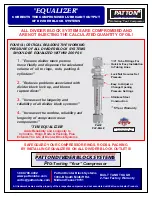
use an extension cord.
The shut-off valve must be
installed
•
In the main water line;
•
In place of or just
downstream from the main
water shut-off valve;
•
Where it is accessible
•
Where the case is protected
from use as a step or from
other excessive loads.
Local electrical and plumbing
codes should be consulted
to ensure that the installation is in complete
compliance. (See Installation section for details.)
Placement of Flood Sensors
Each WaterCop
®
PRO can support an unlimited
number of flood sensors. Additional sensors may be
added at any time. A sensor consists of a transmitter
and a sensor probe (a small disc at the end of the wire,
with two short gold prongs protruding from one side).
Flood sensors should be placed in locations where
leaks are most likely to occur.
Suggested Locations
•
Washing Machines
•
Toilets
•
Dishwashers
•
Icemakers/Refrigerators
•
Kitchen Sinks
•
Automatic Humidifiers
•
Bathroom Sinks
•
Water Heaters
•
Pipes that are prone to freezing (Freeze sensors are
also available)
The transmitter in the flood sensors and the receiver in
the WaterCop
®
PRO communicate by radio frequency.
The smaller the distance between them, the stronger
the signal will be. Transmission distance is somewhat
dependent upon the building layout and type of
construction. The transmitter (attached to the sensor)
must be kept dry. It is NOT splash proof. Sensors
should never be placed outdoors. The sensor probe
detects the water from a leak and is completely
waterproof. Sensor probes should be placed on the
floor or in areas where water would tend to accumulate
rapidly in common leak or overflow situations.
Make
sure that any water from a leak will drain toward
the sensor probe, not away from it.
Avoid high traffic
areas where the cord or sensor could be stepped on
or kicked and where children or pets may disturb
it.
The sensor probe should be placed FLAT on the
floor so water can be detected as soon as it begins
to accumulate.
The sensor probe may be secured to
the floor with screws. To avoid damage to transmitters
and to provide for the strongest signal possible, the
transmitter portion of the flood sensor should be
mounted in a convenient location (on the wall, in a
cabinet, closet, etc.) two to three feet above the floor
(see illustration). (See Installation section for details on
sensor installation.)
Hard Wired Sensors:
Ten foot white cord with single
sensor. PRO sensors are easily secured to floor using
mounting holes. Sensors provide the same feedback
to monitoring station as the wireless WaterCop
®
PRO
sensors. Use hardwired censors for convenience or if
conditions prevent wireless communication. Sensors
sold individually and can be wired with up to 200 feet
of 22/24 AWG 2-conductor cord (not included).
General Safety Information
Warning
Do not apply electrical power to the unit unless the
unit is fully assembled. Failure to do so could result in
personal injury and/or damage to the unit.
Warning
Disconnect power source before working on or servicing
the unit. Failure to do so could result in personal injury.
Caution
It is strongly recommended that eye
protection be worn while servicing the
system. Failure to do so could result
in personal injury.
How the System Works
Flood sensors constantly
monitor their selected
areas for accumulating
moisture. When a leak
is detected, a sensor will
send a radio frequency
signal to the WaterCop
®
PRO unit instructing it
to shut off the water
supply to the home. The
WaterCop
®
PRO
valve
will remain closed until it
is manually reset.
The flood sensors are
a battery powered device enabling it to be located
anywhere a leak is likely to occur, or where water
might cause damage. The WaterCop
®
PRO
requires
household electrical power (common 115 VAC,
grounded outlet) and will not operate during a power
outage.
Selection of WaterCop
®
PRO Installation
Sites
The WaterCop
®
PRO valve should be installed in the
main water line just downstream from the main shut-
off valve in your home. The
front control panel
of
the WaterCop
®
PRO should be easily visible in order
to see what position the valve is in (open/closed). It
should also be easily accessible for resetting after
a leak has been detected and the water supply
has been shut off. While the WaterCop
®
PRO is
completely supported by the piping in your plumbing
system when it is installed, placement of the valve
should ensure that the housing is protected from
use as a step or from other excessive loads. The
WaterCop
®
PRO requires household electrical power,
and the
provided power cord must be plugged into a
properly grounded power source (115 VAC). Do not
2
127,&(
,QVWDOODWLRQPXVWEHPLQLPXPRILQFKHVGRZQVWUHDP
RIDZDWHUPHWHULIZDWHUPHWHULVLQVLGHWKHSUHPLVHV


























